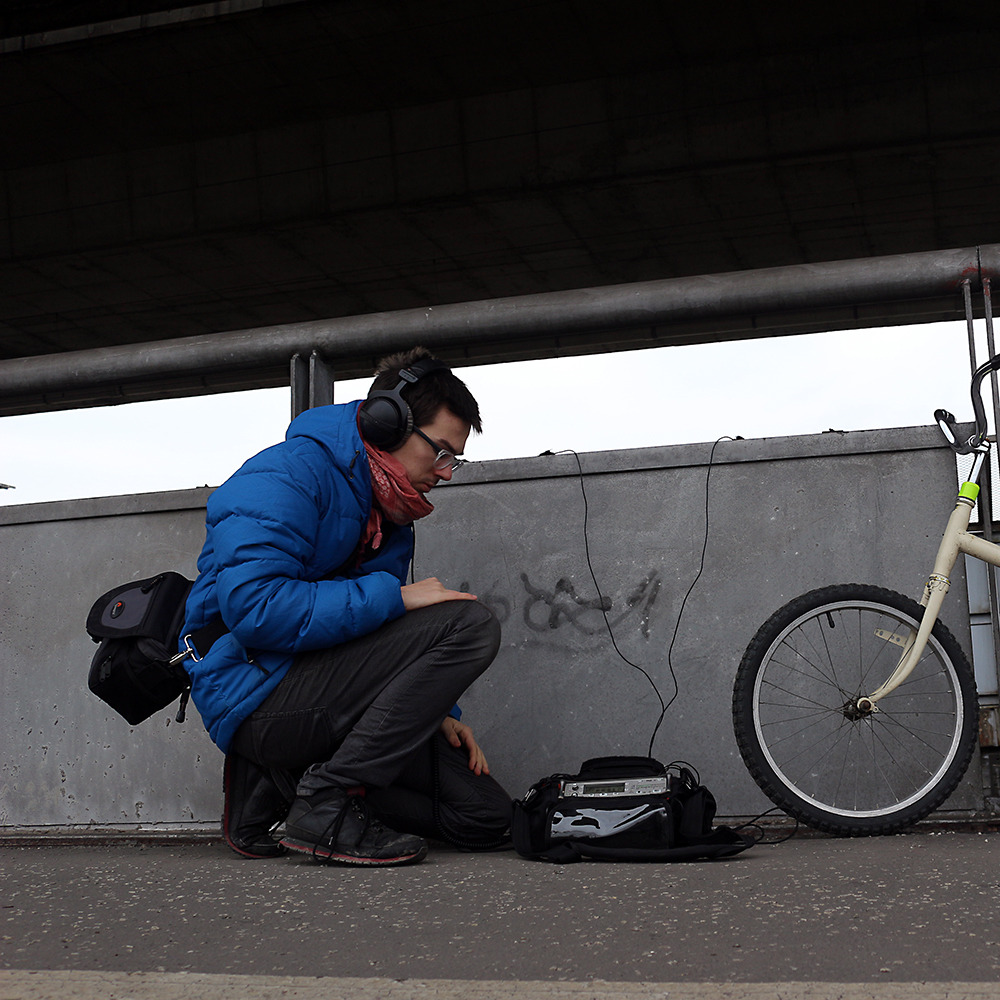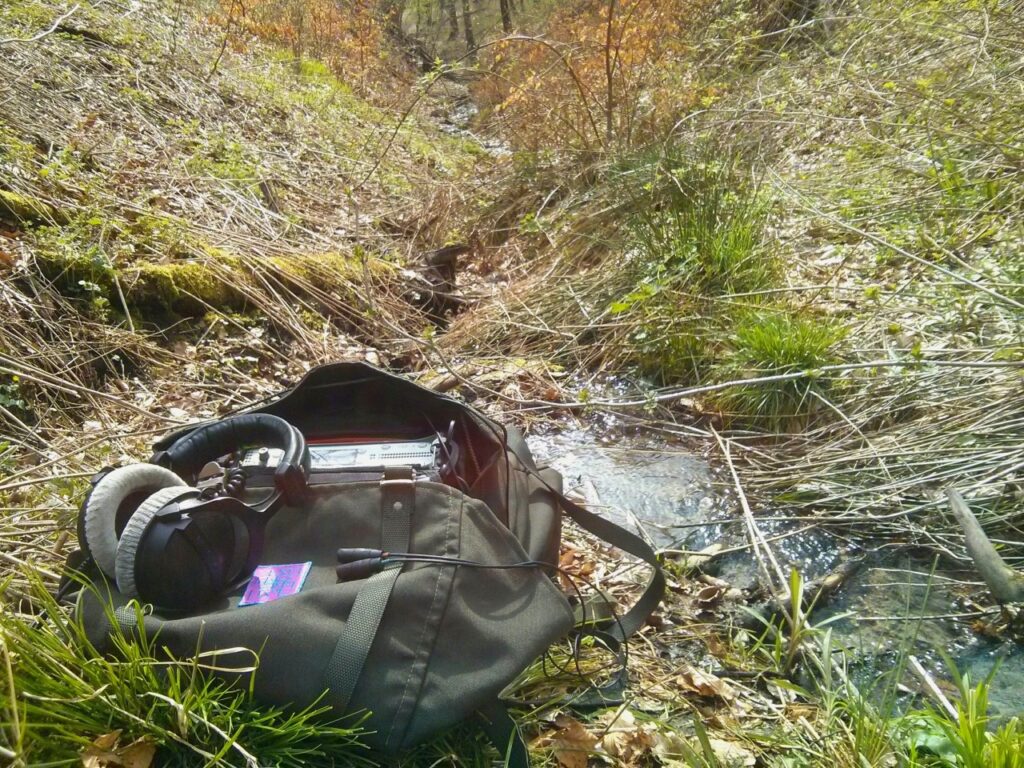Jonáš Gruska: From creating to listening, from PCB to walks
Published April, 2015
by Jakub Juhás

In the past, we’ve written about Gruska on Easterndaze in connection with his project Binmatu, his label LOM or the festival ZVŮK. This interview focuses exclusively on Gruska’s active work and thinking about field recordings. Interview by Jakub Juhás.
When and where did you start to work with field recording?
About five years ago at school, at the Institute of Sonology in The Hague. It was part of the curriculum, when we had to record certain sounds conceptually in various locations in the city. We found a sonically interesting place and subsequently, returned there as a group with our teacher, listened and talked about it. The class started with an analysis of the space and the sounds heard, and only thereafter we started recording. I wasn’t so much into it then. I actively became interested about two years ago.
I’ve read in an interview that it was also a redemption or liberation from the constant need to create, a transition from creation to perception.
It was a change in the sense that I don’t need to create something, I just walked and listened. I had to start going for walks also because of health issues, since I spent a lot of time sat at home bent over soldiering parts. I started to go out and it was nice to record sounds at the same time.
Do you separate these two sonic spheres – the home-based experimentation and recording outside?
Lately, it coalesces. I’m working on my new album with lots of field recordings.
Do you mean the Mosty album?
Currently, I’m trying to get permission to be able to get inside Bratislava’s bridges. I’m focusing on recording three particular bridges – Prístavný, SNP and Lafranconi. By the way, I’ve recently found out that the correct name should be Lanfranconi, so the current name is a misspelling of the name of the Italian engineer after whom the bridge was named. I tried to get in touch with the manager of the engineering networks, who will decide if they let me in or not. So far, there’s been no answer.
Why bridges?
Everything started at the SNP bridge. When I walked over it towards the embankment, I was fascinated by what was happening there. From shaking to rattling, to specific banging on the spot where this bridge interconnects with a steel coupling rod to the land, where cars pass by. This sound is shared by all three bridges. Gradually, I started to walk, ride a bike on other two bridges as well, and the longer I’m recording them, the more remarkably diverse material I’ve amassed. The aim remains to get inside.
How does your preparation for the actual recording look like? If a place catches your attention, do you just listen to it without recording?
Of course, I’m searching for locations and listening or, such as was the case with Lanfranconi, I’m also trying to record. There are two holes, rolls in its construction, in which I inserted microphones to be able to listen what’s happening inside. Various screeching can be heard, and the shape of the tube triggers a weird effect which modulates the sound located inside of the bridge, as well as all of the exterior sonic occurrences. It is similar to a resonating effect in a flute or a whistle, it’s called comb filtering. When you place two microphones into two various tubes, they produce two various tones and same sounds are resonating in various ways. During a chat of random passers by, the tubes become idiosyncratic vocoders. Recording bridges with contact microphones is partly a concept. For me it’s also a personal experience. I was surprised by how many people approached me via the kyberia.sk forum, suggesting a number of sounds that I shouldn’t forget. It only reassured me that it all makes sense, that these are objects, which are present in people’s everyday lives.
You were born and bred in Bratislava. Do you have a relationship to specific sounds of the city? For instance, which sounds come to mind when you think of your childhood?
Glockenspiel on the shopping mall at Kamenne namestie, trams and trolleybuses. In the past, I managed to record the journey with the old type of trolleybuses towards Koliba, an area of Bratislava. Currently, only new buses ride there, which manage this journey up the hill without any issues, but also without the typical groaning. This cannot be recorded anymore. A few days ago, my mini release came out on Sonospace. It’s a short field recording album called Kvilenia Bratislavy. It’s dedicated to my two favourite wailing/squeaking – the door at the main post office and the trams when they are turning. These sounds I hear a lot and gradually became very fond of them.
What is the decisive factor for you when it comes to the choice of the location. Do you focus on architecture, context, atmosphere…?
In the first place it is the aesthetic quality of the sound itself. I cannot imagine that I would record the atmosphere somewhere without being interested in the sound itself. Foremostly, these are various sonic details and quiet sounds, in this case nature is my perennial inspiration.
In your work then, it’s possible to find two antitheses, which mutually coalesce. On one hand, the „sterile“ technical system Vzduchotechnika and on the other, the „natural“ Spevy. How was this album born, whose part is also the song Tečúci vietor, which was included in the Wire’s Below The Radar 19 compilation?
In Spevy, I will focus on various rhythm-based relationships between elements of nature, such as wind and water, which are triggered by certain objects in the composition. Subsequently, I manipulated at home these objects and recorded their new rhythms. A new concept was born, focused on various rhythm connections. You’ll for instance find the sound of the screeching on a pontoon by the Danube, my grandfather’s cans which deter birds, I also used a hydrophone and various other things.
In that sense, you are simply not just a silent observer and listener?
In this and other compositions from Spevy, there’s an element, where alongside recording I also create a regular rhythm. Another example is a song, in which you can hear the wind hitting the flat that’s on a rod standing right by Danube. The flag is pulling the steel rope and dramatically bashes it against the concave column. I then accompany all of this by playing with my fingers on the column and adding a certain regularity. Lately, I’ve been into recording and singing at the same time, simply improvising, as if there was another musician with me.
What do these recordings mean to you or what should they mean to the listener? Shall we search for any stories inside of them, since stories are always present, they communicate.
Vzduchotechnika had a documentary character. The machinery of the market hall at Trnavské mýto in Bratislava is a location, that one hardly manages to enter. I wanted to thus open it to the public and enable it to listen to all those micro-rhythms, beeping and knocking, which exist there.

On your label LOM, you inagurated a new series, entitled Fields, focused on field recordings. When did this idea come about?
Daniel Kordík and Tobiáš Potočný asked me at the time to release an album of field recordings from their travels in India and Portugal. I thought it was the right time to start this edition. Both of them are actively recording. Kordík travelled across India and South-East Asia, where he documented several sonic fragments. Tobiáš works a lot for film, but during his trips, he records sounds exclusively for his own sound library. I also started a mailing list dedicated to this topic, where I’d like to connect people interested in field recordings.
The added value is also the fact, that you produce your own microphones and other technical gear necessary for recording. You finished the first generation of Uši microphones, do you have the feeling that you are even more closely connected to the sound?
A lot of sound artists focused on field recordings do not do it this way, they buy ready-made products. I started to explore this realm more closely because of financial reasons as well. I don’t have the money for microphones, which I’d like to have and since I know something about electro-technology in terms of its technical side, I began to do it alone and found out, that Uši, for instance, are in some respect much better than expensive microphones. They have a lower level of hum and a bigger sensitivity as some of the most popular microphones. On the other hand, expensive microphones have a nicer sound but with Uši, I like the fact they are so quiet. At the moment, I’m making contact microphones, because there are no options, which I need, so I have to do it alone.